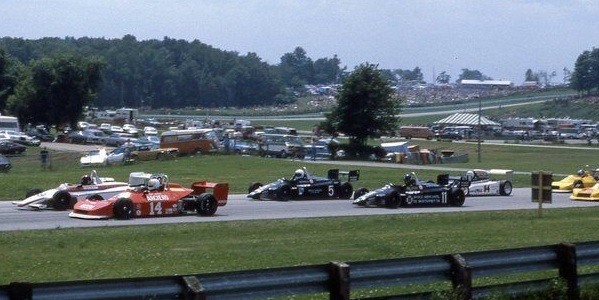
Robert Bosch/VW Super Vee Championship
As Formula Vee had been the SCCA's most numerically viable single-seater category, at least until the appearance of Formula Ford as a class in 1969, the huge US club was keen on introducing FV's big brother when it was announced in 1970. As well as being an SCCA class an National level in 1970, the SCCA introduced a Pro series in 1971, which was well contested by Lolas and Royales. The original combination of air-cooled engines and space-frame chassis changed in 1978 with the introduction of a watercooled engine and monocoque chassis. This raised the series to the same technical level as Formula Atlantic, and a number of FSV drivers were successful at a higher level, notably Geoff Brabham moving into Can-Am in 1980, and Al Unser Jr following him two years later.
In 1982, FSV became CART's regular support series and it thrived as Formula Atlantic fell apart in 1983 and Can-Am went steadily downhill from 1983 onwards. But despite its brief purple patch in the mid-1980s before Formula Atlantic revived, Super Vee's ability to generate new talent faltered after Arie Luyendijk's title win in 1984. In 1986, it was joined on CART's undercard by the American Racing Series, which relegated FSV one rung on the development ladder. With other single-seater racing categories being introduced all the time, notably Barber Saab and Russell Mazda, FSV was struggling to retain its relevance as the 1980s came to a close. There was a plan to move to F3 chassis over the five-year period, but Volkswagen pulled the plug before that could happen. 1990 was FSV's last season.
The 1975 season: Daytona, Sebring International Raceway, Road Atlanta, Laguna Seca, Riverside, Lime Rock, Watkins Glen, Road America, Mosport Park, Watkins Glen, Daytona.
The 1980 season: Charlotte Motor Speedway, Milwaukee Mile, Pocono International Raceway, Watkins Glen, Mid-Ohio, Road America, Brainerd, Minnesota State Fair, Minnesota State Fair, Ontario Motor Speedway, Michigan International Speedway, Watkins Glen, Riverside, Phoenix International Raceway.
The 1981 season: Charlotte Motor Speedway, Milwaukee Mile, Watkins Glen, Road America, Brainerd, Milwaukee Mile, Michigan International Speedway, Riverside, Phoenix International Raceway.
The 1982 season: Phoenix International Raceway, Charlotte Motor Speedway, Detroit, Milwaukee Mile, Road America, Milwaukee Mile, Mosport Park, Michigan International Speedway, Riverside, Laguna Seca, Phoenix International Raceway.
The 1983 season: Long Beach, Mosport Park, Milwaukee Mile, Cleveland, Road America, Pocono International Raceway, Mid-Ohio, Michigan International Speedway, Riverside, Laguna Seca, Phoenix International Raceway.
The 1984 season: Long Beach, Phoenix International Raceway, Milwaukee Mile, Portland International Raceways, Meadowlands Sports Complex, Cleveland, Road America, Watkins Glen, Trois-Rivières, Michigan International Speedway, Laguna Seca, Caesars Palace.
The 1985 season: Long Beach, Indianapolis Raceway Park, Milwaukee Mile, Detroit, Meadowlands Sports Complex, Cleveland, Road America, Watkins Glen, Mid-Ohio, Sanair, Laguna Seca, Phoenix International Raceway.
The 1986 season: Long Beach, Indianapolis Raceway Park, Milwaukee Mile, Detroit, Meadowlands Sports Complex, Cleveland, Road America, Mid-Ohio, Road America, Laguna Seca, Phoenix International Raceway, Tamiami Park, St Petersburg.
The 1987 season: Long Beach, Phoenix International Raceway, Indianapolis Raceway Park, Milwaukee Mile, Detroit, Meadowlands Sports Complex, Cleveland, Road America, Mid-Ohio, Pennsylvania International Raceway, Tamiami Park, St Petersburg.
All results and car histories compiled by Chris Townsend.
Please email Allen if you have any material on US or European FSV race results.